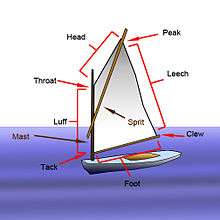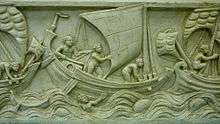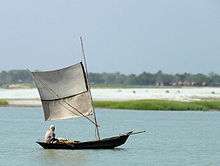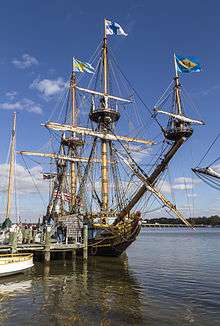Spritsail

The spritsail is a form of three or four-sided, fore-aft sail and its rig. Unlike the gaff where the head hangs from a spar along its edge, this rig supports the leech of the sail by means of a diagonal spar or spars named a sprit.[1] The forward end of the sprit spar is attached to the mast but bisects the face of the sail, with the after end of the sprit spar attaching to the peak and/or the clew of the sail. It is said to be the ancestor from which the common gaff rig evolved in 16th-century Holland. Historically, spritsails were the first fore-and-aft rigs, appearing in Greco-Roman navigation in the 2nd century BC.[2]
Barges

The spritsail was best known from its use in the Thames sailing barge, which employs two similarly sized spars to form the framework for the sail area. In a barge, the mast is stepped vertically in a tabernacle, whilst the sprit is suspended from the mast at an angle of about 30° from vertical, near the mast's foot, with the foot of the sprit to the starboard side of the mast, in a kind of basket, called a muzzle. The sprit is free to move laterally, nearly as far to each side as the shrouds. This enables the vessel to reach and run. The instability caused by allowing such a weighty spar to extend too far away from the vessel's centreline, however, had to be borne in mind when designing hull and rigging. The peak of the sail is permanently attached to the head of the sprit.

The spritsail rig was normally used without a boom. (The latter was usually found on fore-and-aft rigged vessels to keep the mainsail in an aerodynamically efficient shape.) Such loose-footed sails can also be found on the Norfolk wherry and the bawley class of vessels and was a feature of the Cromster. In this last example, the ability to furl the foot of the sail cleared the deck of the sheet while the sail could still be controlled by the vangs. This made gunnery much more readily possible.
In the more usual, commercial vessel, the rig has the advantage of freeing the cargo hatch of obstructions such as the boom but its overriding advantage is met in manoeuvring in very confined waters such as a crowded dock or canal. From the deck, the sail can very readily be set or reduced by very small increments so as to control the power obtained from it. Meanwhile, the boom does not project outboard so that the vessel can reach through a narrow gap between moored vessels. Also, the head of the sail or a similarly controlled topsail can readily be set so as to make use of the air above the wind-shadow of moored ships, warehouses and so on.
This fine control of the sail without need for the crew to leave the deck, is achieved by brailing up. Rather than lowering the mainsail, it is gathered up against its own luff and head by means of lines called brails. This technique is an effective way of stowing the mainsail but more importantly, it gives very fine control over the power obtained from the sail.
However, it means that the sail is stowed aloft and unreachable from the deck. It also means that the sail cannot easily be covered when it is stowed, and thus protected from the elements. But in any case, the crews of working vessels did not trouble with such dainty ways. In keeping with the general philosophy of working boats, all sails would therefore be traditionally treated with red oxide and other substances.
The problem of the inaccessibility of gear was met in the Thames barge by stepping the mast in a tabernacle and using a windlass on the foredeck to strike the whole lot, mast, sprit, sails and rigging. A good crew could sail under a low bridge without losing steerage way. In the photograph, the windlass can be seen below the tack of the foresail and the tackle at the foot of the forestay, which was worked by the windlass, can be seen attached to the stem head. In striking the gear, the foresail tack tackle had to be cast off. The rest more or less looked after itself.

Dinghies
Modern use of the spritsail has also become more common through its use in the Optimist (dinghy) - in the case of which the sprit is tensioned by a snotter arrangement. This much simpler implementation sees the sprit anchored higher on the mast than on barges.
Local boats
The spiritsail is also commonly used in a fore-and-aft rig (along with a staysail) on local traditional wooden boats of the west coast of Norway, most notably the faering variant of the Oselvar.[3] Traditionally, up until the second half of the 1800s, these boats used to be rigged with a square rig.[4]
Square rigged ships

The spritsail yard is used to support the jib-boom and flying jib-boom. The spritsail yard is mounted under the bowsprit,[1] abaft the dolphin striker. The guys supporting the jib-booms are spread along the spritsail yard. Some ships employed a square sail, known as a spritsail, that was bent-on the spritsail yard.
See also
References
- 1 2 Keegan, John (1989). The Price of Admiralty. New York: Viking. p. 280. ISBN 0-670-81416-4.
- 1 2 Casson, Lionel (1995): "Ships and Seamanship in the Ancient World", Johns Hopkins University Press, ISBN 978-0-8018-5130-8, pp. 243–245
- ↑ no:Fil:Oselver.jpg
- ↑ Google Translate
External links
| Wikimedia Commons has media related to Spritsail. |
- This includes a picture of barges with their mainsails, topsails and foresails brailed up
- One of these pictures clearly shows the sprit on the starboard side of the mainsail.
- A barge running and on a starboard tack. Both main and mizzen are spritsails.
- The left-hand picture shows the port vang tackle in the foreground. It is slack because it is to leeward. The mainsheet and loose footed mainsail are visible beyond. The two peak vangs are just visible in the middle picture. In the right-hand picture, the mizzen tabernacle is half-hidden by the belayed ropes and painted green.
- Web article about triangular 'Leg-o-Mutton' sprit sail rig.